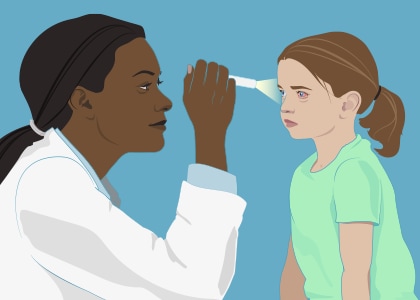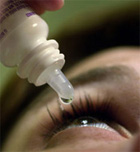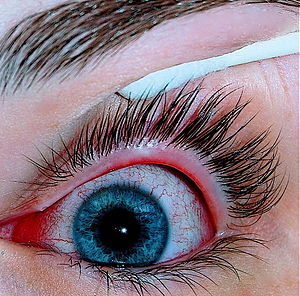Causes, and treatment of Conjunctivitis
Pink Eye: Usually Mild and Easy to Treat

Pink, itchy eyes? Pink eye – or conjunctivitis – is common and spreads easily. It sometimes needs medical treatment, depending on the cause. Know the symptoms, when to seek treatment, and how to help prevent it.
Pink eye, also known as conjunctivitis, is one of the most common and treatable eye conditions in children and adults. It is an inflammation of the conjunctiva, the thin, clear tissue that lines the inside of the eyelid and the white part of the eyeball. This inflammation makes blood vessels more visible and gives the eye a pink or reddish color.
What Causes Pink Eye?
There are four main causes of pink eye:
1.Viruses
2.Bacteria
3.Allergies
4.Irritants (like smog or swimming pool chlorine) that infect or irritate the eye and eyelid lining
It can also be caused by
- chemicals
- Contact lens Wear (especially wearing lenses overnight)
- foreign bodies in the eye (like a loose eyelash)
- indoor and outdoor air pollution caused, for example, by chemical vapors, fumes, smoke, or dust
- fungi
It can be difficult to determine the exact cause of conjunctivitis because some symptoms may be the same no matter the cause.
Viral Conjunctivitis

- Caused by infection of the eye with a virus
- Can be caused by a number of different viruses, such as adenoviruses
- Very contagious
- Sometimes can result in large outbreaks depending on the virus
Bacterial Conjunctivitis
- Caused by infection of the eye with certain bacteria
- Can be caused by Staphylococcus aureus, Streptococcus pneumoniae, Haemophilus species, or, less commonly, Chlamydia trachomatis
- Very contagious
- A leading cause of children being absent from daycare or school [1]
- More common in kids than adults
Allergic Conjunctivitis
- The result of the body's reaction to allergens, such as pollen from trees, plants, grasses, and weeds; dust mites; molds; dander from pets; medicines, or cosmetics
- Not contagious
- Occurs more frequently among people with other allergic conditions, such as hay fever, asthma, and eczema
- Can occur seasonally, when allergens such as pollen counts are high
- Can also occur year-round due to indoor allergens, such as dust mites and animal dander
- May result, in some people, from exposure to certain drugs and cosmetics
Conjunctivitis Caused by Irritants
- Caused by irritation from a foreign body in the eye or contact with chemicals, fumes, smoke, or dust
- Not contagious
- Can occur when contact lenses are worn too long or not cleaned properly
It can be difficult to determine the exact cause of pink eye because some signs and symptoms may be the same no matter the cause.

Signs and symptoms of pink eye can vary but typically include redness or swelling of the white of the eye.

What Are the Symptoms of Pink Eye?
The symptoms of pink eye may vary depending on the cause but usually include:
Redness or swelling of the white of the eye or inside the eyelids
Increased amount of tears
White, yellow or green eye discharge
Itchy, irritated, and/or burning eyes
Increased sensitivity to light
Gritty feeling in the eye
Crusting of the eyelids or lashes
When to See a Healthcare Provider?
Most cases of pink eye are mild and get better on their own, even without treatment. However, there are times when it is important to see a healthcare provider for specific treatment and/or close follow-up. You should see a healthcare provider if you have pink eye along with any of the following:
Moderate to severe pain in your eye(s)
Sensitivity to light or blurred vision
Intense redness in the eye(s)
A weakened immune system, for example from HIV or cancer treatmentSymptoms that get worse or don't improve, including bacterial pink eye that does not improve after 24 hours of antibiotic use
Pre-existing eye conditions that may put you at risk for complications or severe infection.
Conjunctivitis treatment
There are times when it is important to seek medical care for conjunctivitis (pink eye), as the treatment sometimes depends on the cause. However, this is not always necessary. To help relieve some of the inflammation and dryness caused by conjunctivitis, you can use cold compresses and artificial tears, which you can purchase over the counter without a prescription. You should also stop wearing contact lenses until your eye doctor says it’s okay to start wearing them again.
When to Seek Medical Care
You should see a healthcare provider if you have conjunctivitis along with any of the following:
- pain in the eye(s)
- sensitivity to light or blurred vision that does not improve when discharge is wiped from the eye(s)
- intense redness in the eye(s)
- symptoms that get worse or don’t improve, including pink eye thought to be caused by bacteria which does not improve after 24 hours of antibiotic use
- a weakened immune system, for example from HIV infection, cancer treatment, or other medical conditions or treatments
Newborns with symptoms of conjunctivitis should see a doctor right away.
Viral Conjunctivitis
Most cases of viral conjunctivitis are mild. The infection will usually clear up in 7 to 14 days without treatment and without any long-term consequences. But in some cases, viral conjunctivitis can take 2 to 3 weeks or more to clear up.
A doctor can prescribe antiviral medication to treat more serious forms of conjunctivitis for which there is a specific treatment, such as those caused by herpes simplex virus or varicella-zoster virus. Antibiotics will not improve viral conjunctivitis; these drugs are not effective against viruses.
Bacterial Conjunctivitis
 Antibiotics, usually given topically as eye drops or ointment, can help shorten the length of bacterial conjunctivitis, reduce complications, and reduce the spread of infection to others. If your doctor prescribes antibiotic eye drops or ointment, the infection should clear within several days.
Antibiotics, usually given topically as eye drops or ointment, can help shorten the length of bacterial conjunctivitis, reduce complications, and reduce the spread of infection to others. If your doctor prescribes antibiotic eye drops or ointment, the infection should clear within several days.
However, mild bacterial conjunctivitis may get better without antibiotic treatment and without any complications. It often improves in 2 to 5 days without treatment but can last up to 2 or 3 weeks. The use of antibiotics is associated with increased antibiotic resistance and increased costs, and should be a shared decision between the doctor and the patient.
Allergic Conjunctivitis
Conjunctivitis caused by an allergen (such as pollen or animal dander) usually improves when the allergen is removed from the person’s environment. Allergy medications and certain eye drops (topical antihistamine and vasoconstrictors), including some prescription eye drops, can also provide relief from allergic conjunctivitis. In some cases, a combination of drugs may be needed to improve symptoms. Your doctor can help if you have conjunctivitis caused by an allergy.
How Do I Stop Pink Eye from Spreading?
Pink eye caused by a virus or bacteria is very contagious and spreads easily and quickly from person to person. Pink eye that is caused by allergens or irritants is not contagious, but it is possible to develop a secondary infection caused by a virus or bacteria that is contagious. You can reduce the risk of getting or spreading pink eye by following some simple self-care steps:
Wash your hands.Avoid touching or rubbing your eyes.Avoid sharing eye and face makeup, makeup brushes, contact lenses and containers, and eyeglasses.
Newborns with symptoms of conjunctivitis (pink eye) should see a doctor right away.
Neonatal conjunctivitis is a red eye in a newborn caused by infection, irritation, or a blocked tear duct. When caused by an infection, neonatal conjunctivitis can be very serious.
Symptoms and Causes of Conjunctivitis in Newborns

Newborns with conjunctivitis develop drainage from the eyes within 1 day to 2 weeks after birth. Their eyelids become puffy, red, and tender. The cause of neonatal conjunctivitis is often difficult to determine because, in many instances, the symptoms don’t vary by cause.
Conjunctivitis in a newborn may be caused by a blocked tear duct, irritation produced by the topical antimicrobials given at birth, or infection with a virus or bacterium passed from the mother to her baby during childbirth. Even mothers without symptoms (asymptomatic) at the time of delivery can carry bacteria or viruses that can be passed to babies during birth.
The most common types of neonatal conjunctivitis include the following:
- Inclusion (chlamydial) conjunctivitis
Inclusion conjunctivitis is caused by the bacterium called Chlamydia trachomatis, which a mother with untreated chlamydia (a sexually transmitted infection) may pass to her baby during childbirth. Symptoms of inclusion conjunctivitis include redness of the eye(s), swelling of the eyelids, and discharge of pus, and are likely to appear 5 to 12 days after birth. - Gonococcal conjunctivitis
Gonococcal conjunctivitis is caused by the bacterium called Neisseria gonorrhoeae, which a mother with untreated gonorrhea (a sexually transmitted infection) can pass to her baby during childbirth. Symptoms in a newborn with gonococcal conjunctivitis usually include red eyes, thick pus in the eyes, and swelling of the eyelids. This type of conjunctivitis usually begins about 2 to 4 days after birth. - Chemical conjunctivitis
When eye drops are given to newborns to help prevent a bacterial infection, the newborn’s eye(s) may become irritated. This may be diagnosed as chemical conjunctivitis. Symptoms of chemical conjunctivitis usually include mildly red eye(s) and some swelling of the eyelids. Symptoms are likely to last for only 24 to 36 hours. - Other neonatal conjunctivitis
Red eye(s), and swollen eyelids with some pus, are also typical symptoms of conjunctivitis caused by viruses, and bacteria other than Chlamydia trachomatis and Neisseria gonorrhoeae. For example, bacteria that normally live in a woman's vagina and are not sexually transmitted can also cause conjunctivitis. Additionally, the viruses that cause genital and oral herpes can cause neonatal conjunctivitis and severe eye damage. The mother may pass such viruses to her baby during childbirth. However, herpes conjunctivitis is less common than conjunctivitis caused by gonorrhea and chlamydia. During pregnancy and prior to giving birth, women with genital herpes should consult with their physician about ways to minimize the chances of spread to the newborn baby.
Prevention and Treatment of Conjunctivitis in Newborns
To prevent neonatal conjunctivitis, most hospitals are required by state law to put drops or ointment in a newborn's eyes to prevent disease. In the past, silver nitrate was used; it has been mostly replaced with antibiotic eye drops, such as erythromycin.
Neonatal conjunctivitis caused by a bacterial infection may be treated with antibiotics in the form of topical (eye drops and ointments applied to the eye), oral, or intravenous (given through a vein), depending on the severity of the infection and the bacteria that caused it. It can also be treated with a combination of topical, and either oral or intravenous antibiotics. The newborn’s infected eye may also be rinsed with a saline solution to remove any pus that builds up.
If the conjunctivitis is caused by a blocked tear duct, a gentle, warm massage between the eye and nasal area may help. If the blocked tear duct is not cleared by 1 year of age, the newborn may require surgery.
Treatments for the common causes of neonatal conjunctivitis are as follows:
- Inclusion (chlamydial) conjunctivitis
Oral antibiotics are usually used to treat inclusion conjunctivitis. - Gonococcal conjunctivitis
Intravenous (IV) antibiotics are usually given to treat gonococcal conjunctivitis. If untreated, the newborn could develop corneal ulcerations (open sores in the cornea) and blindness. - Chemical conjunctivitis
Since this type of conjunctivitis is caused by chemical irritation, treatment is usually not required. The newborn will usually get better in 24 to 36 hours. - Other bacterial and viral conjunctivitis
Antibiotic drops or ointments for the eye are usually given to treat conjunctivitis caused by bacteria other than Chlamydia trachomatis and Neisseria gonorrhoeae. For both bacterial and viral conjunctivitis, a warm compress to the eye may relieve swelling and irritation. Be sure to wash hands before and after touching the infected eyes.
Thanks








That was an wonderful article about Conjunctivitis
ReplyDelete